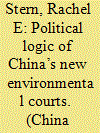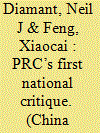|
|
|
Sort Order |
|
|
|
Items / Page
|
|
|
|
|
|
|
| Srl | Item |
| 1 |
ID:
144366


|
|
|
|
|
| Summary/Abstract |
By late 1967, there had been clear signs that China’s Cultural Revolution had entered the phase of retrenchment and moderation. Despite continuing radical extravagance, Beijing’s efforts revolved around taming the divided mass movement and establishing new organs of local power. In this nationwide milieu, the province of Hunan stood out as a remarkable exception. It was in Hunan that there emerged a diffused yet vigorous movement in opposition to Beijing’s attempts to rebuild the Party and state authorities. This movement, the Shengwulian, has been discussed by a number of China scholars. Conventional scholarly wisdom regarding this critical episode, however, seems to be based on several less-than-accurate premises. Using newly available sources, this paper re-examines the Shengwulian episode, with a special focus on how nationally significant issues, radiating out from the political center, played themselves out in relation to local contingencies, cleavages and complex power relationships.
|
|
|
|
|
|
|
|
|
|
|
|
|
|
|
|
| 2 |
ID:
144369


|
|
|
|
|
| Summary/Abstract |
Why do local officials in China often fail to comply with directives of the central leadership in Beijing? Existing scholarship suggests that local defiance results from reform-era decentralization, or from the difficulty of managing agents in a complicated policy environment. In contrast, we conceptualize threats by Beijing to punish local officials as deterrence signals, and analyze local officials’ reactions to these signals as a dynamic process in which they consider the selectiveness, severity and retractability of sanctions, and the reputation of the center, when deciding to defy. Examining the case of Beijing’s application of the seemingly powerful “hold-to-account” practice to curtail investment in iron and steel in 2004, its punishment of local officials in the “Tieben Incident”, and the continued defiance of other local officials, we analyze the dynamics of central–local relations that lead to the failure of the center’s deterrence efforts.
|
|
|
|
|
|
|
|
|
|
|
|
|
|
|
|
| 3 |
ID:
144367


|
|
|
|
|
| Summary/Abstract |
Ma Xiwu’s Way of Judging” emerged in the Shaan-Gan-Ning Border Region in the 1940s. Generally assumed to be a legacy of Communist revolutionary legal practice in civil law and often described simply as a form of mediation, it is in fact, this article argues, a complicated legal process, produced in a particular historical and social setting. Although generalized as the Party’s policy and problematized when it was promoted to a broader geographical and social reality, it presented an attempt by the revolutionary state to bridge local culture and the modern legal system, to reduce antagonism caused by legal formalism. Ma’s Way created procedures for mass participation in constructing a modern judicial system and redefined the dynamic state–society interplays. As an historical tradition in the making since the 1940s, its multifaceted nature allowed its adoption into the contemporary judicial system and community life in a variety of new forms.
|
|
|
|
|
|
|
|
|
|
|
|
|
|
|
|
| 4 |
ID:
144371


|
|
|
|
|
| Summary/Abstract |
This paper examines a work of contemporary art by the artist duo Sun Yuan (b. 1972) and Peng Yu (b. 1974). Entitled Wenming zhu (Civilization Pillar), in form the work resembles a classical stone column, but it is in fact entirely composed of layers of congealed, gleaming human fat. While the work has previously been read in relation to the emergence of zhenhan yishu or “Shock Art” in the late 1990s, I argue that it provides an important mirror on the corporeal aesthetics of the wenming discourse. In Sun Yuan and Peng Yu’s Civilization Pillar, flesh is fetishized as a site for the accumulation of wenming as a by-product of the hedonism and decadence of the 21st century. Wenming is thus defined as the corporeal surplus of burgeoning consumerism, a means by which both to figure and to counter the destabilizing forces of sociopolitical transformation.
|
|
|
|
|
|
|
|
|
|
|
|
|
|
|
|
| 5 |
ID:
144368


|
|
|
|
|
| Summary/Abstract |
China boasts over 130 environmental courts opened between 2007 and 2013, a trend that promises to re-shape environmental law. What accounts for the political appeal of specialized justice? Overall, China’s specialized environmental courts are a method for local officials to signal commitment to environmental protection and a forum to defuse potentially explosive disputes. They symbolize the increasing importance placed by China’s leaders on environmental issues, while also offering welcome flexibility. Courts can accept cases when disputes are rising, and turn them away when local power holders are involved and caution appears prudent. Many courts struggle to find enough cases to survive, and even the most active courts do not necessarily tackle China’s most pressing environmental problems. A new analysis shows that the Guiyang court’s docket is dominated by minor criminal cases—crackdowns against powerless rural residents, rather than more ambitious attempts to hold polluters accountable.
|
|
|
|
|
|
|
|
|
|
|
|
|
|
|
|
| 6 |
ID:
144372


|
|
|
|
|
| Summary/Abstract |
This article is the first detailed exposition of the “National Discussion of the Draft Constitution”. In mid-1954, Chinese engaged in a wide-ranging deliberation about political and social rights, the obligations of citizenship, state symbols, political institutions and ideology. Many asked penetrating and frequently prescient questions about law, citizenship, class and political power, and offered provocative suggestions for revision. Using archives and intra-Party publications, we argue that, for citizens, the constitutional discussion constituted the earliest national-level, semi-public exposé and critique of the entirety of CCP governing practices—a “dress rehearsal” for the 1956 Hundred Flowers Movement. For officials, the constitutional discussion provided an opportunity to deploy the coercive language of “state law” to overcome resistance to collectivization, and a tactic to deal with “unruly” citizens. We further suggest that the 1954 discussion set the terms of broad-based, but ultimately limited, constitutional critique from the 1950s until the present.
|
|
|
|
|
|
|
|
|
|
|
|
|
|
|
|
| 7 |
ID:
144370


|
|
|
|
|
| Summary/Abstract |
In discussing the main forces shaping rapid fertility decline, current studies take the Yicheng two-child program as an example showing that the role of the birth-control policy in China’s fall in fertility is not as strong as commonly thought. Based on a close examination of documentary evidence, this paper demonstrates that the Yicheng program is not vastly different from the national population-control effort with regard to the timing of marriage, the number of children and the childbearing interval. We argue that in Yicheng the two-child policy has done more to effect a demographic transition to low fertility than has socioeconomic development.
|
|
|
|
|
|
|
|
|
|
|
|
|
|
|
|
|
|
|
|
|